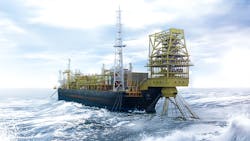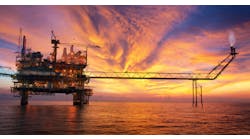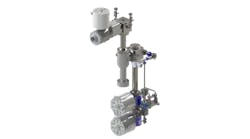Avoid Fluid System-Related Delays During FPSO Construction and Maintenance
Barry Rowe-Platts, Technical Lead, Engineering Services, Swagelok
Tommy Jamail, Regional Construction Manager, Asia Pacific
In recent years, floating production storage and offloading (FPSO) vessels have become increasingly popular as a means of exploiting offshore resource deposits due to their mobility and economical operation. While fully capable of spending years anchored at sea, these vessels can be redeployed as owner/operators’ priorities shift.
While construction of an FPSO requires some different considerations than a fixed platform, similar challenges exist related to coordinating vendors, adhering to tight timelines, and accounting for corrosive conditions. When planning, installing, and maintaining critical fluid systems, here are a few factors to consider setting yourself up for efficient, effective construction and vessel operation.
How to Manage FPSO Fluid System Construction and Maintenance Effectively
Delays in FPSO construction or dry dock maintenance are problematic for everyone involved. For engineering, procurement, and construction (EPC) companies, package vendors, or other contractors, it can mean damaged credibility. For an FPSO owner, it can mean millions of dollars in lost revenue if vessels are stuck in shipyards instead of extracting oil. Still, delays happen every day for a variety of reasons.
- The Challenge of Managing Complicated Logistics
Whether you are constructing a new FPSO or retrofitting an existing hull, coordination between a variety of organizations can be a daily challenge. FPSOs may be built thousands of miles away from where they will operate, and that can mean coordination, shipment, and delivery difficulties. As oil and gas applications have become more complicated and equipment packages have become increasingly specialized, the number of vendors involved in projects has also increased. Several EPCs from different countries may be involved in the design and engineering of dozens of critical applications found on board. Coordination with these EPCs and package vendors starts prior to front-end engineering and design (pre-FEED) and must be managed through system commissioning.
How to Succeed:
Choose suppliers that have experience with FPSO application design and have a local presence. You want partners who understand local cultures, languages, and regulations and the nuances of industrial fluid system operations to minimize issues as you navigate logistics and communications complexities. Look for suppliers with dedicated global construction teams with rich experience assisting with product selection, fluid system engineering, and capital projects management support. - The Challenge of Procuring the Right Products at the Right Time
Given how susceptible offshore fluid systems are to corrosion and given that many components will be exposed to elevated pressures, it is important to choose proven products from reliable suppliers and to make sure those products are built with the right materials for your application. Dealing with exotic alloys and specialized products can come with supply chain hurdles. Availability of components may be limited, and without proper planning, delays in acquiring small parts can lead to big problems. This can cause issues with keeping large-scale construction projects on time and with maintaining system uptime on vessels operating in an isolated oil field. Special consideration may also be required to adhere to industry compliance standards or company environmental sustainability commitments, too.
How to Succeed:
Engage fluid system component providers early (pre-FEED, if possible) to find the right parts with appropriate availability to adhere to capital project timelines. Suppliers should be able to work with you to plan for the procurement of products rated to perform in your operating environment and be able to make asset registries reflecting every product on the vessel so that it’s easier to maintain and repair fluid systems. - The Challenge of Avoiding Premature System Failure Due to Installation Issues
Whether during initial vessel construction or shipyard-based maintenance and repair activities, improper fluid system installation practices can cause major maintenance, safety, and production issues throughout the life of asset. Correct design fundamentals in material selection, routing, support, and installation are essential for system longevity. Untrained personnel can introduce errors that multiply across large installations, reducing safety and reliability while increasing maintenance costs.
For example, during construction, tubing and piping is often exposed to carbon contamination caused by nearby welding, grinding, cutting, or sandblasting work. Without sufficient protection and preservation methods, this contamination can cause significant corrosion issues when stainless steel is exposed to the harsh operating environment, resulting in reduced operational life, increased maintenance needs, and potential safety concerns if left undetected.
How to Succeed:
These issues can be prevented through sound design principles, quality products, installation training, and professional oversight during critical phases. Small-bore tubing specialists can help less-experienced contractors improve competency, prevent problems, and keep projects on schedule. - The Challenge of Ongoing Fluid System Maintenance and Repair
Given that FPSOs are at sea for long periods of time, major maintenance activities usually take place during dry dock and minor maintenance is kept to a minimum. Planning how to deal with fluid system issues is crucial, as expertise in small-bore system troubleshooting is frequently limited offshore. Overlooked problems often surface during shutdowns and dry dock maintenance, causing unexpected scope increases, cost overruns, and schedule delays.
How to Succeed:
Identify knowledge gaps in offshore crews and consider bringing in specialists to evaluate critical fluid systems offshore or in dry dock. Swagelok field engineers often help offshore operators detect root causes of issues, train teams in leak prevention, and provide solutions ranging from expert consultation to turnkey services including design support, product selection, system builds, and implementation assistance.
Working with the Right Suppliers for FPSO Construction Projects
Choosing the right fluid system solutions provider can make a big difference in your ability to avoid FPSO construction/maintenance delays and increase the safety and reliability of your fluid systems. You want partners with the right products available in the right materials and who can help you pivot when issues arise from procurement to production. A partner with industry leading expertise and experience in small bore tube fluid systems with a global technical support network. The right partner can also assist with specifications, recommend efficiencies, help identify cost-saving configurations within various packages, and assist in managing timelines and logistical complexities to help maintain job site inventory and product availability.




